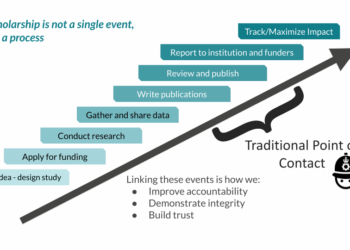Scholarly not-for-profits model themselves on their bigger perceived siblings, and the endowment concepts embraced by academia proper have become the de facto standards for behavior in scholarly not-for-profits. Associations and others are either run or heavily influenced by academics, who reflexively look to academic spending, investment, and governance policies for guidance around their own investment funds.
Endowments at academic institutions in the United States can run between two times and seven times the operating budget. Harvard’s is the largest, at ~$32 billion. Around 65 US universities have endowments over $1 billion. For many, the endowment comes in at more than $1 million per student.
These are large sums of money sitting in the bank. These relatively idle funds underscore the importance of Cowen’s basic question: Why?
Surprisingly, there’s no clear answer.
The term “endowment” is often thrown around as if it’s a single, well-understood thing. In fact, most academic institutions and scholarly not-for-profits have a mix of restricted and unrestricted funds in what they refer to as their “endowment.” The money in these funds generally emanated from surpluses generated years or even decades ago. In this regard, all or a portion of the funds are more like retained earnings in a business.
Finding a clearly stated reason or purpose behind these large sums of retained earnings is surprisingly difficult. A good foundational discussion of possible motivations can be found in a thoughtful piece Henry Hansmann published in 1990. Hansmann explores many possible philosophies institutions may be pursuing in holding onto these funds so long and to such an extent, including intergenerational equity (making life easier for future students), efficiency (using this money when it’s growing faster than incomes), lumpy funding (using these funds to bridge funding droughts), liquidity (bridging downturns), long-term security (extending the business after its core revenues have dried up), and insulation from outside demands (making the institution rich enough to scoff at suitors). Each of these is readily disputed, and a couple are firmly refuted.
For instance, the notion of “intergenerational equity” involves transferring wealth from an earlier generation to a later generation helps ensure fairness. However, Hansmann points out that because there is typically economic growth via even a low rate of inflation, this wealth transfer is essentially from the poorer to the richer — that is, future generations will have more money than prior generations. In this case, it might make more sense for future generations to subsidize the current one — which would mean having the university borrow and the future generation pay this back through higher tuition. A paper by Gilbert and Hrdlicka studies whether universities are investing in a way suggesting they have this as a goal — that is, investing in a low-risk way so that equity is more likely to be preserved. They find that “the objective of maintaining fairness does not appear as the main reason for having an endowment in the first place and certainly for managing it in a very aggressive manner.”
The idea that a sizable endowment or investment balance can serve an organization if all other revenues dry up also doesn’t hold up. As Hansmann writes:
If an ordinary business firm were to sustain repeated losses over many years, it would probably be efficient for the firm to go out of business — and inefficient for the firm to draw on all of its retained earnings from earlier decades to cover its losses.
There are non-strategic reasons Hansmann offers to explain the behavior of academic institutions relative to their endowments. One he calls, “The peculiar perspective of trustees.” As Hansmann writes,
. . . trustees tend to focus a disproportionate amount of their attention on the endowment and make its preservation or growth a special priority. This tendency may be reinforced by the fact that the size and growth of the endowment is a tangible and easily measured thing. . . . consciously or unconsciously, university trustees tend to focus on the size of the university’s retained earnings . . . as a measure of the success of the management of the institution.”
Another behavioral explanation Hansmann offers is the preferences of administrators and faculty. Essentially, job security is equated with endowment size and growth, and this false linkage drives organizational behavior. The caution this linkage creates within an organization marries perfectly with the peculiar perspective of trustees, creating the kind of stasis often seen around endowments. The alignment promotes laissez-faire money management.
A 2009 paper in the Fordham Law Review by Sarah E. Waldeck lends credence to the notion that these last two forces shape most investment policy decisions, even in the faces of economic struggles for institutions and their students. It also notes new interest in these issues in Congress:
. . . some of the losses help put endowment size into perspective and illustrate just how large particular endowments have become. For instance, Yale reported that in fiscal year 2008 its endowment had fallen 25%, to approximately $17 billion. . . . its endowment-expense ratio is likely in the range of 7:1, a number that is more than comfortable. . . . So long as tuition continues to trend upward and worthy research remains unfunded, endowment spending policies are a matter of national concern.
It also seems that when times get tough, institutions get stingy. This and other findings are explored in a paper aptly called, “Why I Lost My Secretary,” in which the authors write:
Over the past two decades, the growth rate of university endowments has far outpaced that of university expenditures. . . . endowments significantly deviate from [their payout] policies following negative financial shocks by pulling back on payouts by more than their formal smoothing policies would suggest.
The authors also note that more-selective universities tend to be stingier, a depressing finding.
It’s striking that behavioral forces seem the most plausible explanations for these huge accruals and stringent spending policies. It strongly suggests that these major institutions have not sufficiently articulated, beyond mere mechanical functioning, a broader philosophy or strategic framework for their endowments or retained earnings.
Companies usually spend when they have useful initiatives to pursue, and save in between spurts of growth, waiting to spend again on worthwhile new ideas and market opportunities. Academic centers seem to have pressures and opportunities for spending aside from pure business growth — defraying tuition increases, adding instructors, funding research, expanding their online offerings, paying for information resources. The list is not insignificant, but in most cases, the money remains tied up in a cloud of what feels like free-floating anxiety.
In another way, academia itself has become a victim of trickle-down thinking, in the sense that in the 1980s, most endowments shifted from bonds and long-term, low-yield assets to stocks, mutual funds, and other risky, high-yield assets. And boards, trustees, and institutions became, by extension, big investors in these instruments. They are now comfortable dealing with investment managers, large portfolios, risk blends, and index funds. As big investors, they think like big investors — perhaps as much as or more than they think as institutional shepherds.
Not-for-profit organizations are generally smaller than major universities, and technology and competition are forces that loom larger in these worlds. Having spending policies in place which celebrate the accumulation of retained earnings over and above the reinvestment of these in a changing business could cause significant long-term damage.
I continue to hear stories of boards that are unwilling to contemplate any deviation from the path of growing the endowment — almost at all costs. The core business may be stagnating, talent acquisition languishing, strategic initiatives going underfunded, and so forth, but as long as the endowment grew in the prior year, all is well. New initiatives that might generate greater returns than leaving money in the bank are short-changed or ignored. This has a circularity to it, like the teen who can’t get a first job because of a lack of experience — not-for-profit management has no track record creating high-yield initiatives from retained earnings because they’re never given funding to pursue new initiatives. In this way, the free-floating anxiety protecting funds in academia transfers itself into unrelated scholarly not-for-profits.
A recent example of this comes in the apparently “good news” story that a former Cornell alumnus has donated $350 million for Cornell to build a high-tech graduate school to be operated in cooperation with an Israeli university. But another interpretation is that Cornell’s trustees waited unnecessarily to pursue such an opportunity. Cornell has a $5 billion endowment. They could have done the same thing by spending 7% of their endowment, roughly equivalent to one year’s returns on a decent investment plan. Why did Cornell have to wait for a rich alumnus to donate the money they could have invested themselves?
One of the core problems may be a reluctance to court risk. We’ve become acutely aware of risk, and have sought ways to eliminate it, from risk management offices to pooled investment funds. Some of this has been beneficial, but there is also a downside — a feeling that any risk can be too much risk, or that taking risk directly instead of indirectly is dangerous or foolhardy. This can lead boards and trustees to accept the risk in markets yet reject risk within their own organizations or institutions.
There’s “plausible deniability” of a sort built into this approach — that is, if funds are depleted because of a broad market downturn, at least everyone’s in the same boat, and nobody can accuse trustees of having taken aboard inordinate amounts of risk.
Yet the hidden risks are perhaps the ones boards and trustees should worry about the most — the evidence of underspending when spending is most needed; a lack of vision for the institution beyond accumulating large sums of idle money; a dependency on risky, mission-deviant investments and investment advisers emanating from Wall Street; a tolerance for speculation broadly writ, with little experience with mission-aligned speculation closer to home; and the size of the endowment as a measure of success, apart from academic, student, or community improvement.
There is also the other obvious possibility — that there is nothing else for academic institutions or not-for-profit publishers to invest in. For academic institutions, this seems implausible — candidates for spending from retained earnings include lower tuition, more scholarships, more financial aid, new online educational initiatives, more instructors, better lab equipment, more research, international growth, and so forth. For not-for-profit publishers, the candidates are probably equally available — new editorial initiatives, moves into adjacent realms of knowledge creation, and so forth. It’s interesting to note that Nature, a for-profit publisher, has been more adventurous than Science, a not-for-profit publisher, a condition that brings to mind Joe Esposito’s post on governance and the not-for-profit publisher. Is being for-profit an inherent advantage? Are for-profits’ manner of raising capital and dispensing with retained earnings part of this advantage?
Academics control and influence scholarly publishing, often in ways we have to work to discern. How endowments are managed have major implications for academic institutions, but they also provide guidance for other not-for-profits, who model the larger inhabitants of the scholarly space. Yet these institutions use their endowments counter-intuitively, manage them in the ways that are difficult to understand given their broader educational and societal remits, are often miserly, and indulge in practices that make a larger endowment an end unto itself.
Boards of not-for-profits of all sizes and shapes should consider examining their utilization of retained earnings. Asking “why?” when it comes to these piles of money is probably asking the key question.
Discussion
14 Thoughts on "Trickle-Down Thinking — Does Anyone Understand Why Universities and Not-for-Profits Have Large Endowments?"
“Why do universities have endowments?” – for the same reason that pigs are fat and that rabbits have lots of babies: because they can, and doing so helps them survive and beat competition that does not do it as well.
Human organizations are “organisms” – subject to the evolution algorithm. The accumulation of wealth and therefore power (or vice versa) helps the organization to survive – just like fat on a pigs or lots of rabbit babies.
Universities have become manufacturing facilities for gift-giving-Alumni. They invest their endowments to maximize the return in getting more endowments. It is the same behavior that turns business into self-serving monsters, or a church dedicated to giving the poor into one of the richest organization in the world.
Are these endowment numbers net of debt? If you have a million and owe a million you do not have a million.
What’s interesting is that often there are so many covenants and/or so much reluctance about touching “the corpus” that institutions go into debt rather than spend from their endowment. Harvard did this in 2009 — they went from $300 million in debt to $600 million in debt, despite having tens of billions in the bank. Other universities had to lay off people despite having sufficient funds on-hand to navigate the downturn. Now that their endowments have recovered, they are still faced with the cash flow challenges of servicing debts they incurred rather than using their own savings.
To answer your direct question, no, these numbers are not net of debt, but most debt levels fall far short of the endowment’s level.
Kent,
One of the things universities can do with an endowment is use it as collateral for borrowing money at very low interest rates. Investors know that Harvard, Yale, Princeton and Cornell have almost no risk of declaring bankruptcy, a fact that allows them to negotiate for sub-prime rates. These institutions keep their endowments invested where they can earn much more money than the interest required to pay off their loan.
You’re right about a lot of endowments having restrictions. Few alumni want to throw money into a general pot. They want their name on buildings or on particular professor’s titles (i.e. “The Harold and Iris Liebowitz Professorship of Molecular Biology”). For library endowments, it can be very challenging because alumni want to endow books in the disciplines they studied. In my previous job, we had huge endowments for poultry science (a department that no longer exists), apiculture, and lace. It becomes a burden to spend all of accrued funds each year. Add this to the risk-adverse nature of librarians and you have a model for endowment growth.
I think tuition increases are a more likely result of the search for low interest rates. Banks really want free cash, not fixed assets, when establishing interest rates for institutions and businesses. If endowments are restricted, tied up in complex investment portfolios, etc., lending becomes a bit more prickly.
One of the other potential rationales for endowment growth I didn’t include in what became a very long post was “prestige.” It’s something both the institutions and their alumni seek to preserve. After all, the marketing value applies to both, and a huge endowment attracts prestige in all varieties — trustees, faculty, research grants, etc. But how much is enough?
If alumni are devoted to an institution, restrictions should be minimal. If they want an ego trip, do they really need to encumber their donations for the ride? My favorite donor is “Anonymous.” That seems to be motivationally pure.
As a Cornell alumni who married a woman who went to Harvard this topic is brought up often in family circles. I know I am jumping in late but I do think prestige hits the nail on the head. Thanks for this interesting article and discussion.
My alma mater, Princeton, has some endowed coaching positions (like men’s basketball) and uses its endowment also for guaranteeing that no student graduates with any debt, all financial support being provided in the form of grants, not loans. There are as many uses for endowments as a university wants to make.
Princeton University Press came to have a sizeable endowment by being so successful in managing the money that came from Paul Mellon to fund the Bollingen Series. Having such an endowment gives PUP a lot of flexibility in deciding what projects to undertake, and it can internally subsidize potentially money-losing projects if its management so desires.(PUP is a separately chartered corporation and not a department of the university.)
At Penn State we got an NEH Challenge Grant that was aimed at building mini-endowments for a dozen different monograph series. This was also the use that the presses at California and Texas made of their Challenge Grants.
The Stanford Encyclopedia of Philosophy is a marvelous example of an open-access ongoing publication funded through an endowment. I see that as a great model to fund OA projects like this.
I agree. Articulating clear purposes will get the money going to the right areas. But it seems more often endowments are left to pile up because that’s viewed as an end unto itself. Money is always a means to an end, in my opinion — and security, predictability, and prestige can be valid ends, but trustees and administrators should say that those are the ends they’re pursuing, not just run on auto-pilot. And they should always check in that those ends are still the right ones.
To play the devil’s advocate, I would just like to point out that universities are degree-granting institutions and that the trustees must make decisions that will ensure the continued existence of said universities to retain the worth of degrees they grant. In essence, the longevity and validation of all degrees ever granted by an institution is contingent upon the continued existence of the institution and, by extension, the endowment. Should universities decide to expand and use endowments to foot the bill, only to come up short because tuition is too high and the general opinion of the public is that college degrees are overrated, the validity of every degree ever granted by such an institution would take a hit. Perhaps the ‘stinginess’ is due to this fact? Thoughts, anyone?
Many universities go by the boards, and not all because of financial woes. The story of Radcliffe College is interesting in this regard. It was absorbed by Harvard between 1977 and 1999. Are those degrees now worthless? I’ll let you tell Margaret Atwood.
Universities and colleges morph, die, merge, change names. I don’t think preservation of degree integrity is a major concern driving endowment conservation or these decisions to consolidate, merge, or modify identities. I think decision-makers are much more worried about revenues (tuition, fees), and consolidation, name modifications, and so forth are driven by these, various marketing theories, and regional pressures.
Here is a new twist: endowments as sources of loans for struggling state governments!
Gov. Jay Nixon of Missouri said today that he would not seek loans from public universities to help balance the state’s budget, the Associated Press reports. Governor Nixon had proposed last month to close a $750-million deficit by asking five universities to lend the state $107-million—interest-free—from their reserve funds. The proposal drew criticism from the universities and from lawmakers, one of whom called it a “Bernie Madoff-type Ponzi scheme.”
Endowments are “idle” funds? What do you mean? Endowment monies are invested to help maintain their value and therefore are part of the engines of capitalism. At state universities, during my academic career, state contributions have gone from paying for a bit more than 2/3s of the cost of an education to a bit less than 1/4th of the cost, and still dropping, With less public support, public universities had to get serious about endowments and the proceeds of those investments help fund things like academic scholarships and to help support those educational facilities that tuition doesn’t pay for. And then there’s the growth of unfunded mandates; don’t get me started.
Employing funds in investment portfolios so that they return to those same funds don’t have the multiplier effect that funds spent would. Also, serving “the engines of capitalism” isn’t in the mission of any university I know of.
Most if not all of the shrinking support from states have been made up in tuition and fee increases. The endowments remain largely untouched, from what the data show, and when there was an economic crisis, layoffs and program cuts ensued, so endowment funds weren’t used to buffer the blow. That’s part of what “idle” means.
It seems one of the main points of the post has been lost, which is that while academic institutions seem adrift when it comes to the purposes of their endowments, non-profits modeling academic institutions have rather carelessly adopted the same approach, yet have fewer constraints and perhaps greater needs.
This all needs more thought than it’s been getting.





